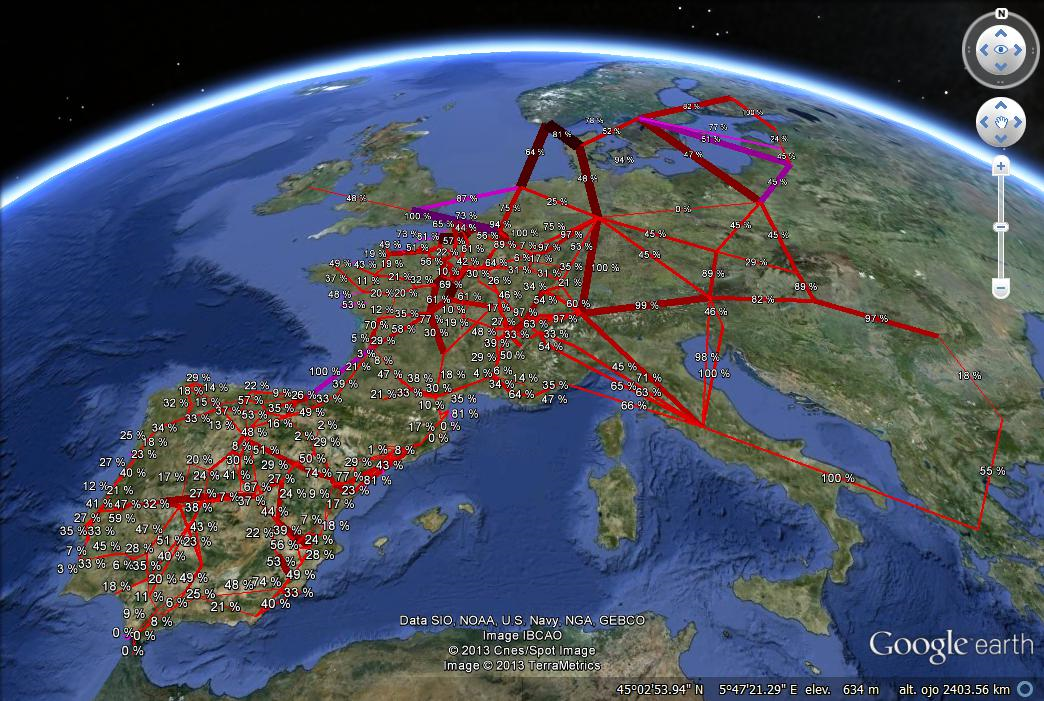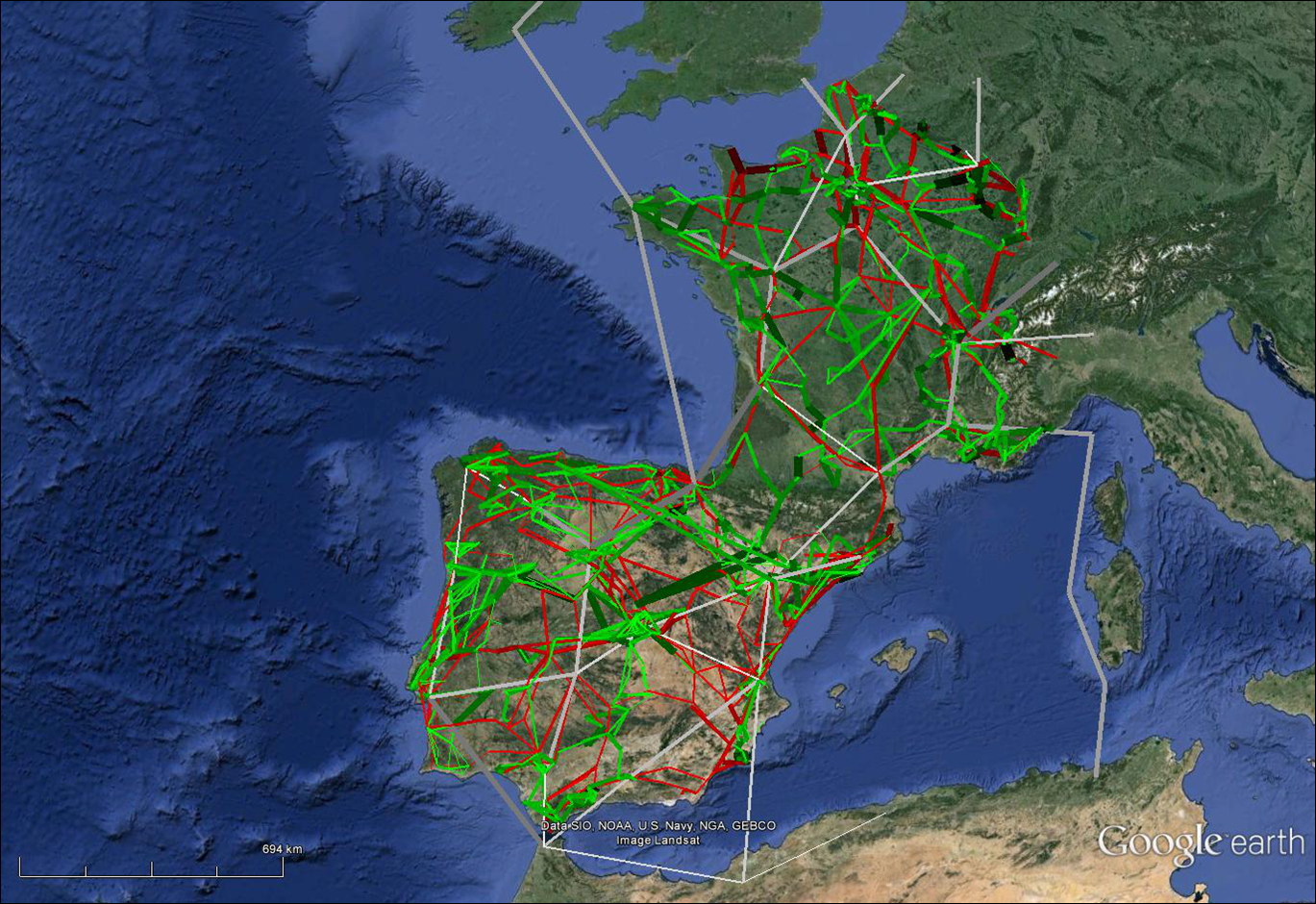
The intermittent nature of the output of most renewable energy resources (RES), its non homogeneous distribution and the deployment of a large share of this generation is expected to result in a significant increase in the power flows among areas in large-scale systems. As a result of this, the development of the network of the system should be planned in an integrated way and the number of operation snapshots to consider in the planning process should probably be high. Identifying main optimal transmission network corridors to reinforce and the extent of reinforcements needed in them, and other operation variables affected by the existence of the grid, like investment cost of grid additions, network losses incurred, CO2 emissions produced, overall production by technology and fuel production costs is a major challenge for large-scale systems. Different future RES generation strategies associated with different RES targets may also strongly influence this network development.
Transmission expansion planning (TEP) determines the investment plans of new facilities (lines and other network equipment) for supplying the forecasted demand at minimum cost. Tactical planning is concerned with time horizons of 10-20 years. Its objective is to evaluate the future network needs. The main results are the guidelines for future structure of the transmission network.
TEPES model presents a decision support system for defining the transmission expansion plan of a large-scale electric system at a tactical level. A transmission expansion plan is defined as a set of network investment decisions for future years. The candidate lines are pre-defined by the user, so the model determines the optimal decisions among those specified by the user, or identified automatically by the model. Candidate lines can be HVDC or HVAC circuits.
The model determines automatically optimal expansion plans that satisfy simultaneously several attributes. Their main characteristics are:
The model represents hierarchically the different time scopes to take decisions in an electric system: Year, Period, Sub-period and Load level. This time division allows a flexible representation of the periods where to evaluate the system operation. For example, by a set of non chronological isolated snapshots or by a set of representative days for different seasons of the year or by a stepwise load-duration curve covering the duration of a year.

The optimization method used is based on a functional decomposition between an automatic transmission plan generator (based on optimization) and an evaluator of these plans from different points of view (operation costs for several operating conditions, or reliability assessment for N-1 generation and transmission contingencies). The model is based on Benders' decomposition where the master problem proposes network investment decisions and the operation subproblem determines the operation cost for this investment decisions and the reliability subproblems determine the not served power for the generation and transmission contingencies given that investment decisions.
The operation model (evaluator) is based on a DC load flow although a simpler transportation representation is allowed for some or all the lines. Network losses can also be considered. By nature the transmission investment decisions are binary although can also be treated as continuous ones. The current network topology is considered as the starting point for the network expansion problem.

The main results of the model can be structured in these topics:
The results are grouped by node, zone, area and region.

This model is currently being used and improved in some European research projects:
Desert Power 2050: Perspectives on a Sustainable Power System for EUMENA

The model is also aimed at computing the benefits of transmission expansion projects by a methodology developed at IIT and also by the two possible approaches proposed by ENTSO-E: the Take Out One at a Time (TOOT) and the Put In one at a Time (PINT).

Some TEP related publications:
S. Lumbreras, A. Ramos How to Solve the Transmission Expansion Planning (TEP) Problem Faster: Acceleration Techniques Applied to Benders Decomposition IET Generation, Transmission & Distribution 10.1049/iet-gtd.2015.1075
S. Lumbreras, A. Ramos The new challenges to transmission expansion planning. Survey of recent practice and literature review Electric Power Systems Research 134: 19-29, May 2016 10.1016/j.epsr.2015.10.013
S. Lumbreras, D.W. Bunn, A. Ramos, M. Chronopoulos Real Options Valuation Applied to Transmission Expansion Planning Quantitative Finance 16(2): 231-246 February 2016 10.1080/14697688.2015.1114362
S. Lumbreras, A. Ramos, L. Olmos, F. Echavarren, F. Banez-Chicharro, M. Rivier, P. Panciatici, J. Maeght, C. Pache Network Partition Based on Critical Branches for Large-Scale Transmission Expansion Planning IEEE PowerTech. Eindhoven, The Netherlands. June 2015 10.1109/PTC.2015.7232344
F. Bañez, L. Olmos, A. Ramos, J.M. Latorre Benefit allocation of transmission expansion plans based on Aumann-Shapley IIT-14-050A, October 2014.
F. Bañez, L. Olmos, A. Ramos, J.M. Latorre Computation of benefits of transmission expansion projects IIT-14-079A, October 2014.
S. Lumbreras, A. Ramos, P. Sánchez Offshore Wind Farm Electrical Design using a Hybrid of Ordinal Optimization and Mixed Integer Programming Wind Energy 18(12): 2241-2258 Dec 2015 10.1002/we.1807
S. Lumbreras Decision Support Methods for Large-Scale Flexible Transmission Expansion Planning PhD Thesis. Universidad Pontificia Comillas. June 2014 (Resumen)
C. Duro Transmission Expansion Planning using a Genetic Algorithm Final project of Engineering Degree. Universidad Pontificia Comillas. June 2014 (Resumen)
S. Lumbreras, A. Ramos, P. Sánchez Automatic Selection of Candidate Investments for Transmission Expansion Planning International Journal of Electrical Power and Energy Systems 59: 130-140, July 2014 10.1016/j.ijepes.2014.02.016
S. Lumbreras, A. Ramos Transmission Expansion Planning using an Efficient Version of Benders’ Decomposition. A Case Study IEEE Grenoble PowerTech. Grenoble, France. June 2013 10.1109/PTC.2013.6652091
M. Banzo and A. Ramos Optimization of AC Electric Power Systems of Offshore Wind Farms in the book P. Pardalos, S. Rebennack, M.V.F.Pereira, N.A. Iliadis, and V. Pappu (eds.) Handbook of Wind Power Systems Springer 2014 ISBN 9783642410796
S. Lumbreras, A. Ramos and S. Cerisola A Progressive Contingency Incorporation Approach for Stochastic Optimization Problems IEEE Transactions on Power Systems 28 (2): 1452-1460, May 2013 10.1109/TPWRS.2012.2225077
S. Lumbreras and A. Ramos Optimal Design of the Electrical Layout of an Offshore Wind Farm: a Comprehensive and Efficient Approach Applying Decomposition Strategies IEEE Transactions on Power Systems 28 (2): 1434-1441, May 2013 10.1109/TPWRS.2012.2204906
S. Lumbreras and A. Ramos Offshore Wind Farm Electrical Design: A Review Wind Energy 16 (3): 459-473 April 2013 10.1002/we.1498
Ch. Egeruoh Long Term Transmission Expansion Planning for Nigerian Deregulated Power System. A systems approach Master Thesis. Universidad Pontificia Comillas. July 2012.
A. Ramos, S. Lumbreras A Dynamic Stochastic Transmission Planning Model Solved by Efficient Benders’ Decomposition 9th International Conference on Computational Management Science (CMS2012) London, UK April 2012.
S. Lumbreras, A. Ramos A Benders' Decomposition Approach for Optimizing the Electric System of Offshore Wind Farms IEEE Trondheim PowerTech. Trondheim, Norway June 2011 (Presentation) 10.1109/PTC.2011.6019371
M. Banzo and A. Ramos Stochastic Optimization Model for Electric Power System Planning of Offshore Wind Farms IEEE Transactions on Power Systems 26 (3): 1338-1348 Aug 2011 10.1109/TPWRS.2010.2075944
P. Sánchez-Martín, A. Ramos, J.F. Alonso Probabilistic mid-term transmission planning in a liberalized market IEEE Transactions on Power Systems 20 (4): 2135-2142 Nov 2005 10.1109/TPWRS.2005.856984
P. Sánchez-Martín, A. Ramos Modeling Transmission Ohmic Losses in a Stochastic Bulk Production Cost Model October 1997
J.I. Pérez Arriaga, A. Ramos, G. Latorre Volumen 1: Guía de usuario del programa de planificación estática de la red de transporte a largo plazo PERLA. Volumen 2: Casos ejemplo. IIT-93-053 Julio 1991 Preparado para Red Eléctrica de España, S.A.
G. Latorre, A. Ramos, J.I. Pérez Arriaga, J.F. Alonso, A. Sáiz PERLA: Un modelo de planificación estática a largo plazo de la red de transporte. Opciones de modelado y análisis de idoneidad II Jornadas Hispano Lusas de Ingeniería Eléctrica 1: 3.46-3.54 Coimbra, Portugal Julio 1991
J.F. Alonso, A. Sáiz, L. Martín G. Latorre, A. Ramos, I.J. Pérez-Arriaga PERLA: An Optimization Model for Long Term Expansion Planning of Electric Power Transmission Networks IIT-91-009 January 1991
G. Latorre, J.I. Pérez Arriaga, A. Ramos, J. Román, J.F. Alonso, A. Sáiz Un modelo de planificación estático de la red de transporte a largo plazo I Jornadas Hispano Lusas de Ingeniería Eléctrica 2: 521-533 Vigo, España Julio 1990.